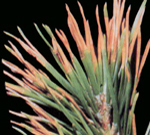Fluoride
Introduction
The air borne fluoride (F) usually in the form of hydrogen fluoride HF is a primary gaseous pollutant other gases like silicon fluoride SiF4 and fluorine (F2) are also reported as phytotoxic. It is released in the atmosphere mainly from aluminium industries, steel manufacturing industries and phosphate fertilizer plants. Like SO2, it is an accumulative poison. Most soil contain some soluble fluoride, background concentration in the soil may reach 1%, although it is generally less than 0.05% (500 ppm) in typical agriculture soils. Soil fluoride is normally taken up by plants only in small amounts. The background concentration in plants is low, often as low as 1 and less than 10 ppm in most species (Weinstein, 1977). However a few species such as hickory and dogwood as well as members of Theaceae, Diapensiaceae, Melastomataceae, Rubiaciae and others (Davison, 1983) have the capacity to accumulate hundreds, even thousands of parts per million, even when the atmospheric and soil available F concentrations are at background levels. (Weinstein, 1977, Davison 1982, Weinstein et al 1999). Generally no relation exists between the fluoride content of the soil and fluoride in the plants growing in it (Fluhler et al 1981). Rather it is the atmospheric fluorides that are most critical to excessive accumulation and plant response.
Injury SymptomsIntroduction
Fluoride enters the plant primarily through the stomata and passes into the transpiration stream where it is carried to its final site of accumulation in the tips and margins of leaves (Romell 1941, Jacobson et al 1969). If the accumulation of F exceeds a threshold for that species, marginal & interveinal chlorosis are usually the first symptoms observed. Depending on the species, anthocyanosis, necrosis and growth distortion may also occur. Little F moves downward in plants to roots, from leaf to leaf or from leaves to fruits (Led better et al, 1960). In addition to foliar injury, fluoride can damage fruits. For example, on peaches it causes a problem known as suture (a seamlike join on the fruit) soft spot that makes the fruit unmarketable.
Indicators
Some plants are extremely sensitive to fluorides and they acts as bioindicator of fluoride. Chronic exposure over long periods of time can result in translocation to leaf tips and margins where visible symptoms are exhibited.
Coniferous tree

Many species of Pine are sensitive to fluoride pollution. Young leaves and needles are most sensitive to F. Fluoride injury on conifers begins at the needle tips and progresses basally, typically leaving a succession of reddish-brown bands across the paler brown necrosis. Frequently necrosis appears as red/purple bands distinctive from healthy tissue. Needles are most sensitive as they emerge from the fascicle in the spring and elongate over the next few weeks. They become progressively more tolerant with the season. Needles formed in previous years are more tolerant and rarely injured by current exposures. Fluoride is a gas and it spreads over readily. It can enter in needles and leaves directly, after which it dissolves in the cellular fluids, builds up and becomes concentrated, leading to cellular destruction. Many types of damage result from these processes, with common symptoms including yellowing and discoloration of needles in conifers and necrosis followed by defoliation in deciduous trees.
Deciduous trees and shrubs
The leaves of deciduous trees & shrubs show marginal and tip necrosis which turn into sharply defined red/brown bands between necrotic and healthy tissue. Necrosis in fruiting parts of trees has also been observed. Generally, all deciduous broad-leaved plants were low in fluorides in the spring. The leaf F content increased during the growing season. The F accumulation rate (K) varied with species and exposure conditions.
Herbs/grasses/crops
Many species show a water soaked appearance on the leaves followed by necrosis in response to acute NOx exposure. Leaf glazing has been observed in annual poa, cabbage and spinach. Nectrotic streaking and interveinal necrosis has been recorded in many narrow-leaved & broad-leaved species. Legumes among many other species show ivory necrosis while some species display yellow, orange or brown necrosis. Tip necrosis has been observed on other plant parts such as awns, bracts & sepals.
Bryophytes
Injury to leaves of several moss species growing in the vicinity of a phosphorus factory in Newfoundland, Canada was recorded to varying degrees of severity at distances of upto 12 Km from the emission source (Roberts Thompson and Sidhu 1979). Roberts et al (1979) and Sidhu (1979) reported that F accumulation in the moss, Polytrichum Commune was about 10 times greater than in needles of balsam fir Abies balsamea in the inner fume zone of a phosphorus plant in Newfoundland. The much larger accumulation in the moss than in balsam fir might be interpreted as reflecting the much greater resistance of Polytrichum Commune and the sensitive of Abies balsamea to F.
Lichens
Lichen appear to be very sensitive native receptors to airborne F. The thalli contain large numbers of ion exchange sites, resulting in their capacity to accumulate elements in high concentrations. Where F is present in the atmosphere, toxicity often occurs in the form of change in color and morphology. Lichens turn grayish-white in colour, colony size is reduced and finally colonies separate. Accumulation of F in the range of 25-80 ppm in a number of lichen species appears to be critical or threshold level at which injury is produced (Nash, 1971; Gilbert, 1971; Roberts and Thompson, 1980; Davies, 1982).Rope and Pearson (1990) reported levels of fluorine in Lecanora melanophthalma two to four times greater at Idaho National Engineering Laboratory sampling sites than at two reference sites approximately 60 km away. Le Blanc et al 1970, described the effects of F pollution from an aluminium smelter on transplanted disks of Parmelia sulcata and was able to detect injury after 4-12 months of exposures at distance upto 15 km from the source. However, the atmospheric concentrations were not measured so dose-response cannot be estimated. In general, the algal symbiont appears to be more sensitive than the fungal symbiont.
